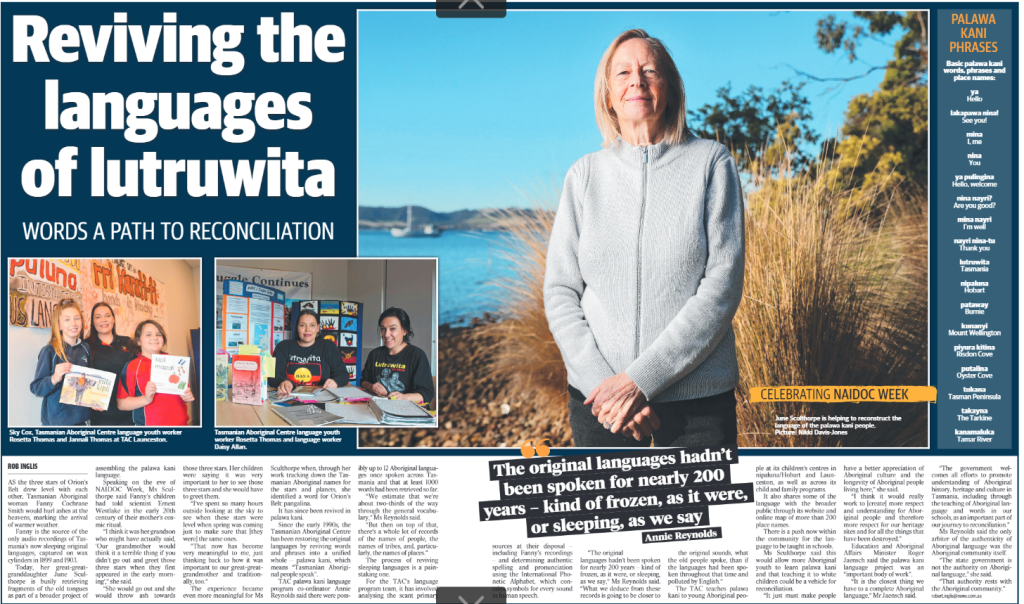
The Mercury newspaper has written about the extraordinary work to wake our language.
A double-page spread appeared in The Mercury at the start of NAIDOC Week 2022 to celebrate the waking of language through the palawa kani program.
June Sculthorpe tells a story about Fanny Cochrane Smith welcoming three stars in the morning and how this has inspired her to track down Tasmanian Aboriginal words for stars and planets. She has identified the word for Orion’s Belt as pangalina.
Annie Reynolds, palawa kani language coordinator, explains that up to 12 Aboriginal languages may have been used across lutruwita. The palawa kani program has retrieved at least 1000 words, and Annie says there is more to find.
Congratulations to June and all who are working on the language program and teaching language to the community.
For more information about the language program, visit our palawa kani webpage.
Read the full article below.
Reviving the languages of Lutruwita
WORDS A PATH TO RECONCILIATION
ROB INGLIS
Published in The Mercury
As the three stars of Orion’s Belt drew level with each other, Tasmanian Aboriginal woman Fanny Cochrane Smith would hurl ashes at the heavens, marking the arrival of warmer weather.
Fanny is the source of the only audio recordings of Tasmania’s now sleeping original languages, captured on wax cylinders in 1899 and 1903.
Today, her great-great granddaughter June Sculthorpe is busily retrieving fragments of the old tongues as part of a broader project of assembling the palawa kani language.
Speaking on the eve of NAIDOC Week, Ms Sculthorpe said Fanny’s children had told scientist Ernest Westlake in the early 20th century of their mother’s cosmic ritual.
“I think it was her grandson who might have actually said, ‘Our grandmother would think it a terrible thing if you didn’t go out and greet those three stars when they first appeared in the early morning’,” she said.
“She would go out and she would throw ash towards those three stars. Her children were saying it was very important to her to see those three stars and she would have to greet them.
“I’ve spent so many hours outside looking at the sky to see when these stars were level when spring was coming just to make sure that [they were] the same ones.
“That now has become very meaningful to me, just thinking back to how it was important to our great-greatgrandmother and traditionally, too.”
The experience became even more meaningful for Ms Sculthorpe when, through her work tracking down the Tasmanian Aboriginal names for the stars and planets, she identified a word for Orion’s Belt: pangalina.
It has since been revived in palawa kani.
Since the early 1990s, the Tasmanian Aboriginal Centre has been restoring the original languages by reviving words and phrases into a unified whole – palawa kani, which means “Tasmanian Aboriginal people speak”.
TAC palawa kani language program co-ordinator Annie Reynolds said there were
possibly up to 12 Aboriginal languages once spoken across Tasmania and that at least 1000 words had been retrieved so far.
“We estimate that we’re about two-thirds of the way through the general vocabulary,” Ms Reynolds said.
“But then on top of that, there’s a whole lot of records of the names of people, the names of tribes, and, particularly, the names of places.”
The process of reviving sleeping languages is a painstaking one.
For the TAC’s language program team, it has involved analysing the scant primary sources at their disposal – including Fanny’s recordings – and determining authentic spelling and pronunciation using the International Phonetic Alphabet, which contains symbols for every sound in human speech.
“The original languages hadn’t been spoken for nearly 200 years – kind of frozen, as it were, or sleeping, as we say,” Ms Reynolds said.
“What we deduce from these records is going to be closer to the original sounds, what the old people spoke, than if the languages had been spoken throughout that time and polluted by English.”
The TAC teaches palawa kani to young Aboriginal people at its children’s centres in nipaluna/Hobart and Launceston, as well as across its child and family programs.
It also shares some of the language with the broader public through its website and online map of more than 200 place names.
There is a push now within the community for the language to be taught in schools.
Ms Sculthorpe said this would allow more Aboriginal youth to learn palawa kani and that teaching it to white children could be a vehicle for reconciliation.
“It just must make people have a better appreciation of Aboriginal culture and the longevity of Aboriginal people living here,” she said
“I think it would really work to [create] more respect and understanding for Aboriginal people and therefore more respect for our heritage sites and for all the things that have been destroyed.”
Education and Aboriginal Affairs Minister Roger Jaensch said the palawa kani language project was an “important body of work”.
“It is the closest thing we have to a complete Aboriginal language,” Mr Jaensch said. “The government welcomes all efforts to promote understanding of Aboriginal history, heritage and culture in Tasmania, including through the teaching of Aboriginal language and words in our schools, as an important part of our journey to reconciliation.”
Ms Reynolds said the only arbiter of the authenticity of Aboriginal language was the Aboriginal community itself.
“The state government is not the authority on Aboriginal language,” she said.
“That authority rests with the Aboriginal community.”
robert.inglis@news.com.au

